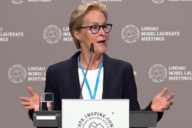You have /5 articles left.
Sign up for a free account or log in.
How do you build a higher education technology consortium from scratch?
Colorado State University, Indiana University, the University of Florida and the University of Michigan last summer announced the formation of Unizin, a digital learning consortium, with a call to action for universities to “shape the future in ways that best serve the noble mission that is higher education.” The consortium, the members said, would aim to speak with one voice on topics related to digital education, make collective decisions and potentially save its members some money in the process.
Seeking to find out what universities gain from membership, the higher education consultant Phil Hill last month obtained a copy of the contract the University of Florida signed with Unizin. The contract spelled out that becoming a member of the consortium meant three things: paying Unizin $1.05 million over three years, following Unizin policies and designating Unizin representatives.
Other than promising access to “an evolving ecosystem of digitally enabled educational systems and collaborations,” Unizin “agrees to nothing,” Hill wrote in a blog post. Besides, he added, “What does access mean?”
(The mere existence of a contract is a sign of progress, however. An open records request submitted last summer to the University of Michigan, another founding member of Unizin, failed to turn up a contract.)
In interviews with Inside Higher Ed, Unizin members said much of the work within the consortium has happened “behind the scenes” since last year's launch. But recently, there have been more public signs of activity. In addition to acquiring software from the electronic textbook platform CourseLoad, Unizin last month welcomed the entire State University System of Florida to the consortium, effectively doubling the number of member institutions.
While members said they are satisfied with the progress made in the first year, the chief operating officer, Robin Littleworth, who came to Unizin from the private sector, said he “selfishly” wished the consortium was farther along.
“I want to deliver what we said we’re going to deliver, and deliver it as fast as possible," Littleworth said in an interview. “Time is of the essence as the fall term is nearing.”
Unizin’s first major features are two “relays” -- one for content, the other for analytics. Details about the relays are still scarce. The content relay is more or less a search engine that would enable faculty members to quickly search repositories for learning objects and plug them into their courses, Littleworth said, while the analytics relay would collect information about how content, apps and platforms are used.
The CourseLoad software will serve as the foundation for the content relay, but it still needs to be retooled to serve that purpose. Originally scheduled for release this spring, the content relay is still “weeks, months” away, Littleworth said. He did not specify a timetable for the analytics relay, saying vendors “aren’t ready to deliver it yet.”
The two relays are the “building blocks” of Unizin, Littleworth said, and once they are in place the consortium will be more willing to talk about larger goals.
University administrators overseeing their participation in the consortium described the past year as a period of reorganization that is likely to extend into the future. While they acknowledged a “hunger” from outside critics to see tangible milestones, the administrators described their membership as a long-term investment, not a one-time purchase.
“There’s that old saying, ‘sometimes it’s better to journey hopefully than to arrive,’” said Patrick J. Burns, vice president for information technology and dean of libraries at Colorado State. Burns said he didn’t know if Unizin would ever “arrive” in the sense that the consortium would run out of topics to tackle, but added, “it’s a good ride.”
Unizin members are primarily working on testing which apps and platforms should become part of the consortium’s shared set of tools and services. Unizin has organized a central teaching and learning group of academic leaders at member institutions -- “boots on the ground,” Littleworth called it -- who can connect the consortium’s leadership with faculty members. The organizational model has spawned a handful of task forces of faculty members from multiple universities working together to recommend what Unizin should do on topics such as antiplagiarism software, accessibility and learning analytics.
Several administrators, citing their participation in organizations such as the Committee on Institutional Cooperation and Internet2, said they felt the consortium model adopted by Unizin is the appropriate way for universities to discuss the role of digital learning in higher education.
“We’re getting a voice at the table to move an ecosystem for education ahead much faster than what it’s moving right now,” said Margaret A. Jesse, a senior director in the ITS office of teaching, learning and technology at the University of Iowa. “We couldn’t get it done by ourselves. We’d have to pick and choose, and I don’t know what we would pick and choose.”
The annual tab of $350,000 is a steep price for a “voice at the table,” but Lois Brooks, vice provost for information services at Oregon State University, put the sum into context. Spending $350,000 on salaries “buys me about two and a half staff people. I could not begin to accomplish what we’re doing with Unizin with two and a half people,” she said in reference to the consortium's work on learning analytics and interoperability standards.
The $350,000 is not what future members will pay to be a part of Unizin, however, but a fee for “founding investors” to get the consortium running. The standard membership fee has not yet been set, according to Burns. The Florida system, as Hill discovered, will pay $100,000 a year for associate membership.
Unizin is already “financially stable,” Littleworth said.
Different universities pointed to different reasons for joining Unizin in the first place. Iowa, for example, stressed content management and learning analytics; Oregon State, a desire to live up to its land-grant status; and Ohio State, accessibility and affordability.
“We want to be in control of our path and where we go,” said Michael B. Hofherr, chief information officer at Ohio State. “When you come together and put Florida and Indiana and Michigan and Ohio and Iowa at the table, you really could have a much different conversation than you could have singularly. Hopefully that’s for the better.”




